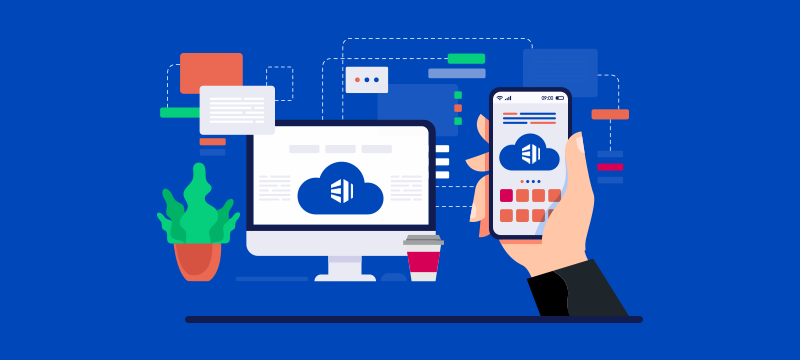While cloud migration offers businesses a wide range of benefits, like all IT systems, there are security concerns that need to be addressed. In this post, we will discuss six cloud app security issues you will need to defend against.
- Cloud misconfiguration
One of the most common reasons for data breaches is cloud misconfiguration – when a cloud service or resource is not set up correctly. Improperly configured cloud infrastructure can leave sensitive data and programs vulnerable to cybercriminals. What’s more, it can be challenging for businesses to ensure that only authorised users have access to their cloud-stored data due to the open nature of the infrastructure and the emphasis on data sharing.
Some common types of cloud misconfiguration include unrestricted inbound and outbound ports, failures in secret-data management (e.g., passwords, encryption keys, API keys, and admin credentials), leaving the Internet Control Message Protocol (ICMP) open, unsecured backups, lack of validation in cloud security, unblocked non-HTTPS/HTTP ports, and excessive access to VMs, containers and hosts.
To prevent cloud misconfigurations, organisations should implement security best practices for their cloud-based assets, including two-factor authentication, encryption, permission checks, regular misconfiguration audits and strong security policies. Those responsible for cloud apps should also be well-versed in security tools to avoid unexpected misconfigurations.
- Data loss
Data loss, especially of customer data and intellectual property, is a significant security concern in cloud computing as it can render the information unusable or result in its complete erasure or corruption.
One of the primary advantages of the cloud is the ease with which data can be shared by both internal and external parties. However, a potential security risk is that data transmission in the cloud is often done through direct email invitations or general links distributed to specified user groups.
To prevent data loss or leakage in cloud apps, there are several data security practices that organisations can implement. These include evaluating third-party risks, monitoring all network access, identifying sensitive data, securing all endpoints, implementing Data Loss Prevention (DLP) software, encrypting all data, and evaluating all permissions.
- Cyberattacks
Cybercriminals specifically target cloud-based infrastructures that lack proper protection. For this reason, businesses need to assess their vulnerabilities and perform security checks to defend themselves. Here are some ways that you can prevent cyberattacks in cloud applications:
-
Keep software and operating systems up to date with the latest security patches
-
Use firewalls to block unwanted network traffic
-
Install and keep antivirus and anti-malware software up to date
-
Don’t open email attachments from unknown senders
-
Train staff about security best practices
-
Implement a data backup plan
-
Review data access permissions
-
Use encryption to protect sensitive data
-
Take password security seriously (e.g., enforce strong passwords and use two-factor authentication.)
-
- Insider threats
Insider threats generally fall into two categories: those that are malicious, such as a disgruntled employee, and those that are unintentional, such as someone who clicks on a malicious email link. For these reasons, employees, contractors or anyone with access to a company’s data can pose significant security concerns. Indeed, over a quarter of data breaches are caused by insiders, making it challenging to detect potential threats when they are involved. To defend against this, effective security measures are needed to detect harmful insider behaviour before it impacts business processes.
To minimise the risk of insider threats to a cloud app, it can be helpful to implement least privilege access controls, use activity monitoring and logging to identify suspicious behaviour, and educate users about security risks. At the same time, you should keep apps up to date and restrict access to sensitive data
- DDoS attacks
DDoS (distributed denial of service) attacks occur when attackers bombard a cloud app with traffic from multiple sources to take it offline. As many companies rely on cloud apps, a DDoS attack is seen by cybercriminals as a way to disrupt their victim’s business operations. Attacks can render websites and customer-facing applications inaccessible for days.
Symptoms of a DDoS attack include slow or inaccessible websites or servers, traffic from specific IP addresses, devices sharing a common behaviour profile, or multiple requests sent to a single URL or resource on a site.
To stop a DDoS attack, you need a powerful firewall that can identify and block malicious incoming traffic.
- Weak API security
Cloud-based systems and application programming interfaces (APIs) are commonly used for both internal and external data exchange. However, APIs are a favourite target of hackers because they provide valuable features and data to exploit. Some common issues with application-level security in the cloud are insufficient monitoring, free and secret access without authentication, reuse of passwords and tokens and the use of direct messaging for authentication. Hackers can exploit these vulnerabilities to bypass authentication processes via APIs. To prevent this, protecting APIs and securing API gateways should be a part of any risk management plan.
Conclusion
While the cloud offers many advantages for businesses, it also presents security challenges and risks. Unlike traditional data centres, cloud infrastructure requires a different approach to security that traditional security tools and strategies cannot fully address. Hopefully, from reading this article, you’ll now be aware of the cloud app security challenges businesses face.
Looking for a managed cloud solution with built-in security? Visit our Cloud Servers page.


